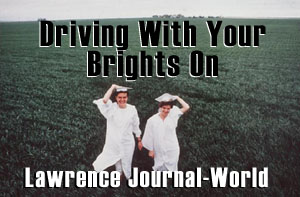|
DRIVING WITH YOUR BRIGHTS ON "My Grandfather and father both told me, 'Dolph, you take care of Lawrence, and Lawrence will take care of you.' " Dolph Simons, Jr, is the third generation of his family to serve as editor and publisher of the Lawrence Journal World. Situated between Topeka and Kansas City, Mo in northeast Kansas, the 20,000-circulation daily might easily be mistaken for just another small town newspaper. In reality, it's a beacon for journalistic talent, a stronghold of principle and tradition and most unlikely of all, an example of how newspapers should be serving their community, with an eye on the future of media. W.C. Simons, the current publisher's grandfather, arrived in Lawrence driving a horse and buggy and had $50 in his pocket when he started The Journal World in 1891. At the time, the town boasted eight newspapers and Simons intended to start number nine. Under his editorship, which he eventually passed on to his son Dolph C. Simons, the paper has not only survived but thrived over the years. The Journal World has operated with a clear understanding of its mission to serve the community in ways that the larger papers surrounding it couldn't. Lawrence is also home to the University of Kansas, a highly regarded educational facility that also has a reputation for outstanding basketball teams. In the years following World War II, Lawrence grew at a rate of 1,000 people a year, which has continued unabated. Dolph Simons, Jr, understood the importance of this , at a time when many small towns were losing their populations. The Journal- World announced that fact with a page one headline, "Lawrence is Growing " . In 2001, The Journal World announced the beginning of a major series, that would dominate the newspaper, News6, and the online edition with a page one headline, "Lawrence is Growing!" The mission it stated in a sub-head, was to "recognize that Lawrence is growing and will continue to grow, and to provide a forum for the open exchange of ideas, comments, suggestions, opinions, complaints and issues with the goal of affirming common ground among a diverse community." Tom Eblen, a former Kansas City Star
editor who recently retired as a KU journalism professor thinks the
Journal-World is unique in its approach to journalism. "No
other paper around here has done anything like that," he said. "Dolph is among the most future-oriented people in the industry", says Tom Curley, the new president of The Associated Press. "He is constantly on a search for the ways to improve his operations." While Snead was lighting creative fires, Simons was searching for ways to keep on top of a rapidly changing media landscape. He was one of the first in the state to invest in cable systems, and today Lawrence serves the community with one of the finest small-market cable operations in the country. Meanwhile, they were also keeping their eyes on the emergence of the World Wide Web. Under the leadership of executive web producer Rob Curley, they designed a web site for the paper that immediately started to garner national awards. For Curley, the key to success was simplicity itself. "You need to know what the 10,000 pound gorilla is for your community and with us, it's the Jayhawks." He stared to design deep websites that could offer Jayhawks fans anything they needed to know about their favorite team, including plays, photo stories and seating charts. "I realized that doing world-class journalism has absolutely nothing to do with how many papers you sell on Sunday," says Curley. "I also realized that this may not be the best place to practice journalism in Kansas, but may be the best place in the world. There may not be another paper like this." Then there is that word that sends panic
into the heart of the most intrepid reporter..convergence! The Journal-World's printing plant , one of the best in the midwest, also prints the company's five Lawrence area weeklies and USA Today . As the importance of photographs became obvious, Simons insisted that the paper would print directly from the plates, something few papers would do, which resulted in excellent reproduction. Photographers, under Snead, were encouraged to take spend more time on stories. Because of his years working in Washington, he also encourages world-class photographers to allow the Journal-World to print their stories. Recently, David Hume Kennerly was featured in two full-page layouts, one on inside the war decisions at the Pentagon, and another on an essay he did on the Supreme Court. Keeping their eye on convergence, the paper sent staff photographer Mike Yoder to the first Platypus Workshop. The videos the photographers produce are not only used on the paper's web site, but also by the cable TV channel. The main purpose of getting the video training was not so much what the paper could use immediately, but how it could position itself for the future, as broadband entered more of its reader's homes. It is just this kind of focus on
the future that makes this little newspaper stand out. © 2003 Dirck Halstead
|
|||
| See the Video: Conversations with Bill Snead & Interviews with Dolph, Curley, and Brack of the Lawrence Journal-World
To view these interview clips, you must have |
|
 Bill Snead - Senior Editor |
Hi Band |
 Dolph Simons, Jr. - Publisher |
Hi Band |
|
Hi Band |
 Ric Brack - Managing Editor |
Hi Band |
Enter
Driving With Your Brights On - Lawrence Journal World
|
Write a Letter
to the Editor |

